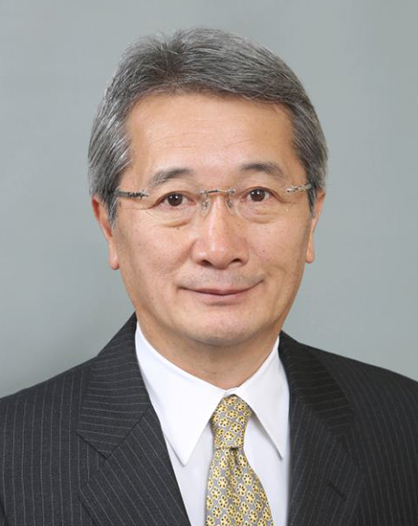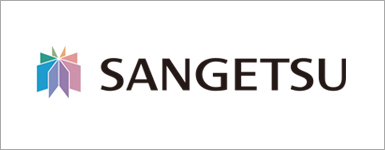| Sangetsu Co., Ltd. (8130) |
|
||||||||
Company |
Sangetsu Co., Ltd. |
||
Code No. |
8130 |
||
Exchange |
First Section, Tokyo and Nagoya Stock Exchanges |
||
Industry |
Wholesale (Commerce) |
||
President |
Shousuke Yasuda |
||
HQ |
1-4-1 Habashita, Nishi-ku, Nagoya-shi |
||
Year-end |
March end |
||
URL |
|||
* Stock price as of closing on June 12, 2015. Number of shares issued at the end of the most recent quarter excluding treasury shares.
|
||||||||||||||||||||||||
|
|
* Estimates are those of the Company. 1 to 2 stock split was done on Aprill 1, 2015. EPS and DPS are calculated retroactively.
|
|
| Key Points |
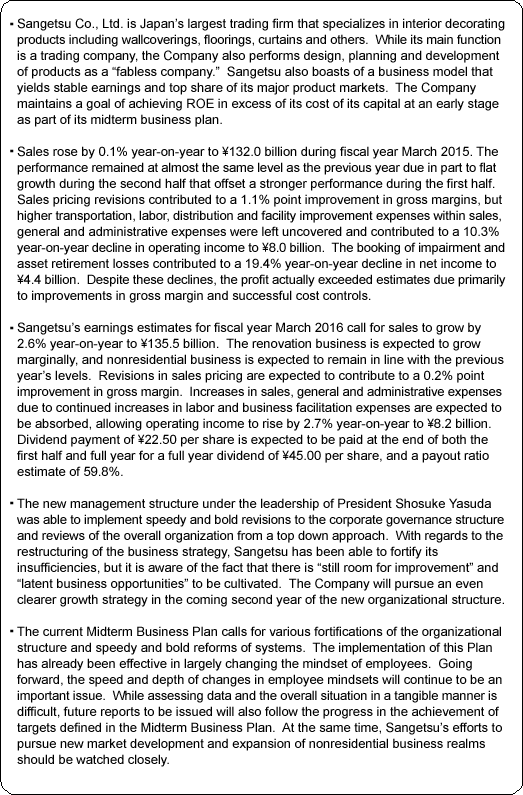 |
| Company Overview |
|
The Sangetsu Group includes the following two companies: Sungreen Co., Ltd., a dedicated distributor of exterior products, and Yamada Shomei Lighting Co., Ltd., a planner, designer, manufacturer, and distributor of lighting equipment. <Corporate History>
Sangetsu was founded in 1849 under the original name of "Sangetsudo" to sell various traditional Japanese interior decorating products including scrolls, wall scrolls, folding screens, sliding doors, partitions, and other products made of cloth and paper. Sangetsu Co., Ltd. was incoeporated in 1953 by the founding family. From the latter half of the 1970s onwards, the business was expanded into Tokyo, Fukuoka, Osaka and other parts of Japan. In 1980, Sangetsu was listed on the Second Section of the Nagoya Stock Exchange, and later in 1996 its shares were also listed on the First Section of the Tokyo Stock Exchange. Currently, Sangetsu is expanding its operations into overseas markets and has established itself as the largest total interior decorating product provider within Japan, with a widely recognized brand of interior products.Shosuke Yasuda was appointed as the first President who is not from the founding family of Sangetsu in April 2014. He will direct the Company during its third stage of growth entitled "Our Third Founding Phase," following on the heels of the original first phase of founding and the second phase when the company became a publicly listed corporation. <Corporate Philosophy>
Sangetsu maintains a corporate motto of "integrity," and endeavors to uphold the "Three Principles of Sangetsu," which are described below, in all of its business activities. In addition, Sangetsu seeks to contribute to society through the provision of products with high value addition that enriches customers' home environments and lives.
 <Market Environment>
The market environment for the main wallcovering and flooring products is strongly influenced by trends in the Japanese construction market. Declines in new housing start arising from declining population and changing family structures within Japan, and deflationary trends have depressed sales of the interior products market as shown in the graph below.
◎ Overview 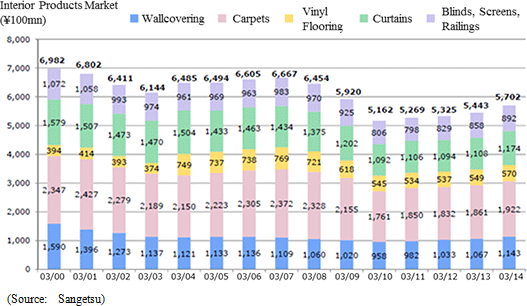 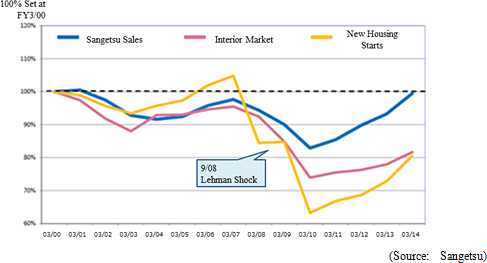 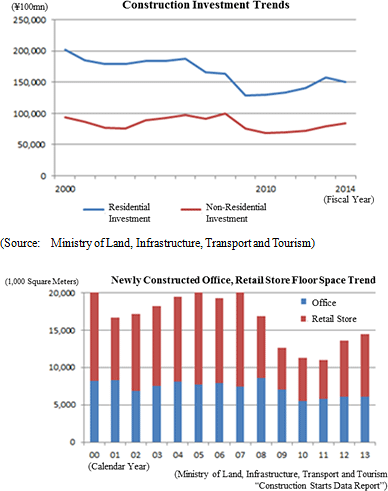 Moreover, the Research Institute of Construction and Economy issued a report entitled "Outlook for Construction Investment Based upon a Construction Economy Model" (October 22, 2014) that calls for continued growth of 7.6% and 2.4% year-on-year growth in private sector non-residential investments during fiscal years 2014 and 2015 respectively, following on the heels of 11.1% year-on-year growth recorded during fiscal year 2013. Aging of the population due to declining birthrates is contributing to a long-term decline in new housing starts and overall difficult conditions. However, the approach of the 2020 Tokyo Olympics is expected to contribute to favorable conditions to continue in the private sector non-residential construction market for the foreseeable future. ◎ Competitors
In addition to Sangetsu, there are three publicly traded competitors that operate in the interior decorating market.
 <Business Description>
The main businesses include planning, development and sales of wallcovering, curtains, upholstery and other interior products. Sangetsu boasts of a "fabless operation" and does not maintain any manufacturing facilities, but its capabilities exceed that of typical trading firms and all of the products it sells are planned, designed and developed in-house. In addition, Sangetsu provides exterior products and lighting fixtures through its subsidiary.
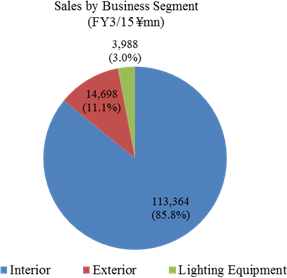 ① "Interior Business"
(FY3/15: Sales and Operating Income of ¥113.364 and ¥7.550 Billion) 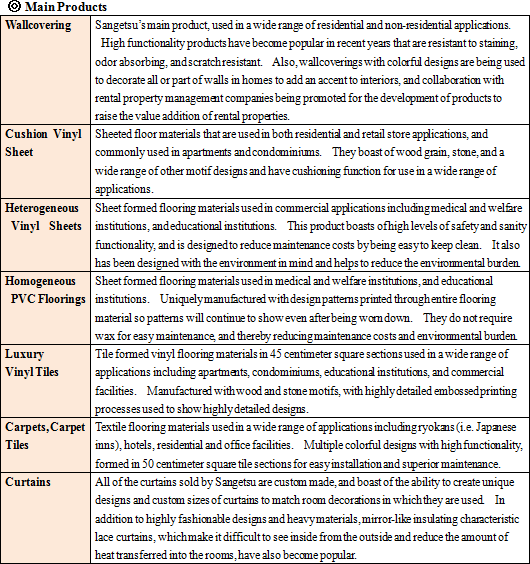 Replacement of existing products is not a simple task. Disposal of products leads to wastes, but the disposal of existing products due to replacement with newly designed products is necessary to maintain the attractiveness of the product catalog and to satisfy customers. Therefore, the ability to maintain a balance between attractiveness and efficiency is highly important and is one of the strengths of Sangetsu. ◎Marketing Structure
In addition to the headquarters located in Nagoya, Sangetsu maintains 8 regional offices and 55 marketing offices throughout Japan, with 6 of these marketing offices also hosting showrooms.
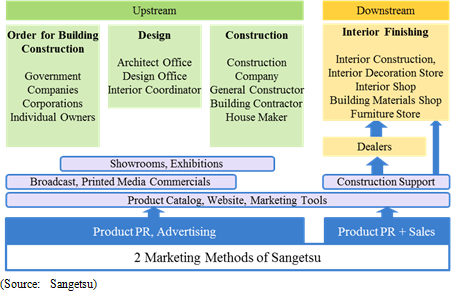 Therefore, Sangetsu conducts public relations and advertising for its products in its product catalog, television commercials and at its showrooms. In addition to these "passive" marketing activities, Sangetsu also conducts "proactive" marketing of its products through its corporate marketing division and its 400 marketing staff to provide and gather information and propose products to clients. While the main marketing efforts are conducted through dealers, Sangetsu also conducts direct marketing to customers in the Nagoya and surrounding Chubu area, and the number of its directly accessed customers totals 6,000 in these regions alone. While the number of customers dealt with through dealers is not known, the total number of customers is estimated to amount to several tens of thousands nationwide. ◎Distribution Structure
Sangetsu maintains a network of 13 distribution centers nationwide. Most all products are normally stocked at the Company's distribution centers in Tokyo, Nagoya, Osaka and Kyushu, with the number of products shipped from these centers surpassing 60,000 per day and the out-of-stock ratio amounting to a low 0.13% (About 70 products) per day. Sangetsu's nationwide distribution network makes"Just-in-Time" provision of products to match the interior construction schedules of its clients possible. Products are sourced from a wide range of over 100 supplier companies.
② "Exterior Business"
Sungreen Co., Ltd., which was turned into a subsidiary in 2005, sells doors, fences, terraces and other exterior products within Japan.
(FY3/15 Sales and Operating Income of ¥14.698 Billion and ¥455 Million) ③ "Lighting Business"
Yasuda Shomei Lighting Co., Ltd., which was turned into a subsidiary in 2008, sells down lights, z-lights and other general lighting fixtures within Japan.
(FY3/15 Sales and Operating Income of ¥3.988 Billion and ¥30 Million)  Specifically, Sangetsu "seeks to reduce its capital from the end of March 2014 by ¥10.0 to ¥20.0 billion within three to five years" as part of its efforts to achieve a ROE ratio of 8% to 10% by fiscal year 2017 to 2019. Consequently, the Company will implement efforts to raise profitability in addition to this capital strategy. 2.Characteristics and Strengths
① Business Model Capable of Yielding Stable Earnings
Sangetsu is a pioneer in the realm of "fabless companies" that do not maintain their own manufacturing functions and therefore have lower fixed expense burdens because they don't have to carry facilities for the manufacturing process. In addition, the Company boasts of over 13,000 products, sourced from over 100 suppliers, supplied to several tens of thousands of customers, which diversifies risk in many ways. And while Sangetsu's may be considered as an economically sensitive company as its business and earnings performances are closely linked to trends in the construction market, the Company has never seen losses since its founding.
② "Creating," "Proposing," "Providing"
While the actual manufacturing of products is not conducted in-house, Sangetsu performs the planning, design and development functions internally. The previous generation of Sangetsu management made aggressive investments for "unique designs," one of the three principles of the Company. 20 in-house designers develop new and original versions of products based upon numerous basic designs. The cultivation of designers responsible for various products is done through participation in oversea exhibitions, communication with marketing staff, and discussions with outside design consultants as part of their on-the-job training. Furthermore, Sangetsu maintains a policy of aggressively taking the perceptions and opinions of younger designers and staff into consideration. Sangetsu also boasts of an overwhelming number of products of about 13,000 that far exceeds the number of products of its competitors. In addition, the Company conducts revisions of its products on a regular basis every 2 to 3 years with 28 categories of product catalogs, which far surpass those of its competitors.
"Creating" 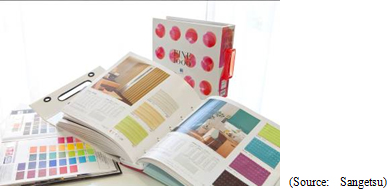 "Provide"
As mentioned earlier in this report, Sangetsu normally maintains inventories of all of its products so that they can be provided on a "Just-in-Time" basis using their nationwide distribution network. However, the Company is required to conduct speedy processing techniques as product orders are placed so that loss rates can be limited to avoid the maintenance of excess inventories and reduced efficiencies. Some wallcoverings are produced in rolls as long as 50 meters, and Sangetsu cuts these rolls into shorter segments when orders are placed for shipment. The remaining segments of wallcovering are then cut to match other orders to eliminate losses. This type of custom-made cutting technology has been cultivated over the long years of experience in the interior decorating business and is an important factor that differentiates Sangetsu from its competitors.
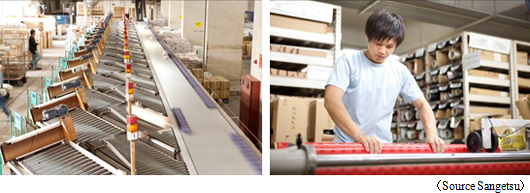 "Propose"
Nearly one third of all employees or some 400 work in marketing functions at Sangetsu, the largest marketing function within the industry. These marketing staff are assigned to 63 offices located throughout Japan and conduct proposal- based marketing to clients. Sangetsu also staffs its six showrooms with 64 employees. In addition, 51 interior designers create design boards that combine samples of various products for customers to use when choosing interior products. This high level of proposal-based marketing capability is unmatched within the industry and sets Sangetsu apart from its competitors.
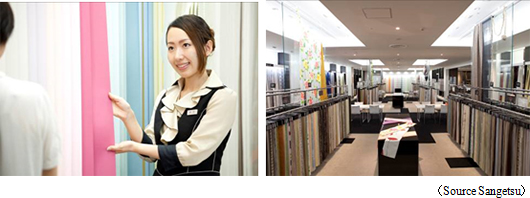 |
| Fiscal Year March 2015 Earnings Overview |
 Fortified Marketing Function Contributes to Higher Sales, but Higher SG&A Expenses Lead to Lower Profits
Sales rose by 0.1% year-on-year to ¥132.0 billion on the back of the issuance of a new product catalog, efforts to fortify design and marketing towards clients, and new product development in refurbishment and non-residential realms. And while business trended favorably during the first half of the term, conditions worsened during the second half and business remained only in line with the second half of the previous term.Revision of sales pricing to reflect higher raw material costs allowed gross margin to improve by 1.1% point from the previous term. However, higher sales, general and administrative expenses resulting from rises in transportation, labor (salary increase, promotion, etc.), policy costs such as facility improvement expenses for logistical equipment and office buildings associated with business facility improvement were left uncovered and contributed to a 10.3% year-on-year decline in operating income to ¥8.0 billion. The booking of an impairment loss of ¥1.1 billion based on the assumption of the sales of real estate holdings such as employee dormitory facilities and an asset retirement loss of ¥0.1 billion contributed to a 19.4% year-on-year decline in net income to ¥4.4 billion. Despite these declines, these results actually exceeded estimates due primarily to improvements in gross margin and successful cost controls. (2) External Environment
<Related Market Conditions>New housing starts during fiscal year 2014 declined by a relatively large margin of 1.8% year-on-year to 880,000. While this decline had little impact upon business performance upon the first half of the term, it did have a large negative impact upon the second half due to the time lag between housing starts and interior facilitation of about four months. Demand for refurbishment was also negatively impacted by the rush to beat the consumption tax and declined in the aftermath of the hike. Interior construction in non-residential applications suffered from a shortage of labor and increases in materials costs. <Materials Markets> Shipment volumes of wall coverings fell by 2.3%, 9.4% and 6.0% year-on-year during the first half, second half and full year respectively. While shipment volumes contracted, Sangetsu's share of the market expanded. Within the flooring materials category, carpets saw a 29.6% year-on-year decline in the full year and carpet tiles used primarily in offices fell by 1.2% year-on-year, while long flooring materials rose by 0.6%. Floor tiles used in retail stores also fell by 0.6% year-on-year, but the share of industry-wide sales actually rose. 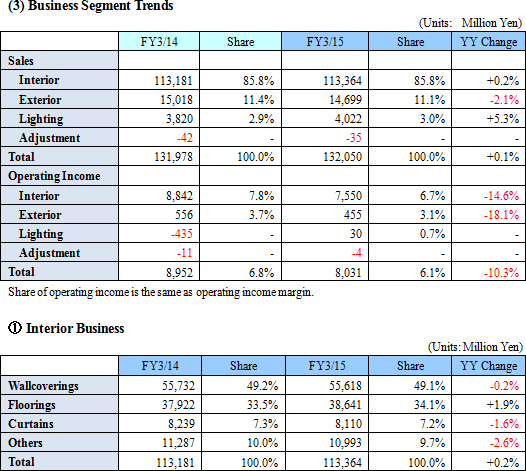 <Wallcoverings> While the three new product catalogs "Reserve 1000", "REATEC", and "XSELECT" were published, the decline in new housing starts due to the rush to purchase ahead of the consumption tax hike in the previous term contributed to weaker demand in the refurbishment market and a decline in sales. At the same time, raw material price hikes continued from the previous term led to a rise in purchase pricing. However, Sangetsu has been able to gain the understanding of customers in the market and thus been able to pass along these higher prices through increases in their sales pricing. This in turn has allowed gross income to rise. <Floorings> Expansion in the market for non-residential applications including medical, welfare related and commercial facilities, and favorable trends in high functionality products with superior maintainability and shock absorbing function allowed sales to grow. However, increases in costs caused by higher materials prices and the weakening of the yen held gross income to similar levels as the previous term. <Curtains> Despite improvements in gross income margin due to pricing revisions released along with the new product catalogs, stagnant demand in the new housing starts market and the negative influence of the rush to purchase ahead of the consumption tax hike in the previous term contributed to lower sales. ② Exterior Business
The exterior products market was also negatively impacted by the decline in new housing starts, and especially from October onwards, the inability of demand to recover in excess of the level of last year's pre-tax hike demand surge, contributed to declines in both sales and profits. However, aggressive efforts to strengthen marketing functions including the establishment in February 2014 of Yokohama Branch allowed sales in the Tokyo and surrounding Kanto region to rise by about 30%. ③ Lighting Business
Efforts were made to strengthen sales of value added lighting products to medical, hotel, office and other non-residential realm applications. Furthermore, particular emphasis was placed upon marketing efforts to architectural design and lighting design offices. As a result of these efforts, sales to non-residential applications and overall sales rose. The recovery in orders for products for which evaluation losses were recorded during the previous term realized profits to be realized after losses in the previous term.
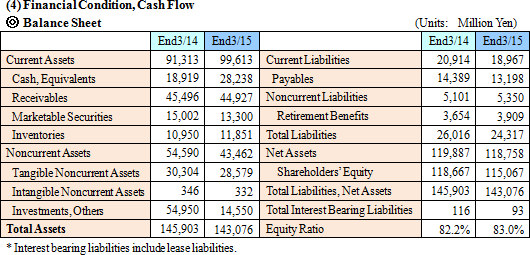 Declines in accounts payables contributed to a ¥1.9 and ¥1.6 billion declines in current and total liabilities to ¥18.9 and ¥24.3 billion respectively. Net assets declined by ¥1.1 to ¥118.758 billion on the back of declines in retained earnings. Equity ratio rose by 0.8% points year-on-year to 83.0%.  Increases in acquisition of treasury stock led to a large increase in the net cash outflow in financing cash flow. As a result of these changes, cash position increased. One issue is the increase in working capital despite the flat growth in sales. Sangetsu's recognition of this issue has led it to establish "the Return on Invested Capital Improvement Committee" to promote reforms. |
| Fiscal Year March 2016 Earnings Estimates |
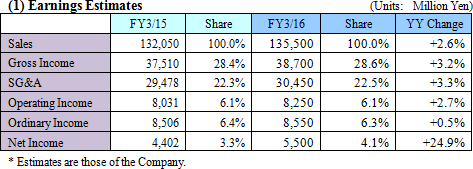 Small Increases in Sales, Profits Expected
Sangetsu's estimates call for sales to rise by 2.6% year-on-year to ¥135.5 billion. During the full year, new housing starts are expected to grow marginally, but the interior business is expected to suffer from stagnant demand during the second half of the previous year. Refurbishments are expected to rise by a small margin and non-residential realm business is expected to remain in line with the previous fiscal year. Corrections in sales pricing are expected to offset increases in costs during the first half, and a reduction in products which saw evaluation losses is expected to allow gross income margin to improve by 0.2% points. Higher labor costs arising from increases in pay and promotions as part of reforms in the human resources system, efforts to strengthen design capabilities and business foundation fortification efforts are expected to continue leading to increases in SG&A expenses. However, the increase in sales is expected to absorb these costs and allow operating income to rise by 2.7% year-on-year to ¥8.2 billion. Due to the disappearance of impairment and asset retirement losses that occurred in the term just ended, net income is expected to rise at a double-digit rate, 24.9% year-on-year. Dividend of ¥22.50 per share are expected to be paid at the end of both the first half and full year for a full year dividend of ¥45.00 per share. The anticipated dividend payout ratio is 59.8%.
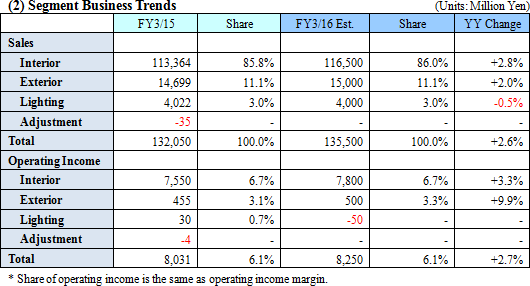 |
| Achievements of the Mid-term Business Plan, 2014-2016: Next Stage Plan G |
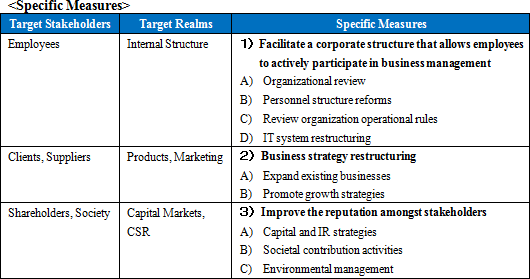 1) Business Foundation Facilitation
Fortification of Corporate Governance StructureAlong with the implementation of a "corporate auditor committee company structure" as of the general shareholders meeting held on June 18, the founder and chairman and senior executive director, and six new directors including President Yasuda and five corporate auditors (outside directors) were appointed. At the same time, a new director compensation system that is linked to the earnings and share price performance of the Company was introduced. Also introduced was a mandatory retirement system. All in all, the changes represent aggressive and large changes in the structure of Sangetsu. Employee Awareness Reforms Promoted A net income target of ¥6.3 billion has been established for the paid for stock option (350 employees and directors of the Sangetsu Group are eligible to receive these options) along with a 6% cost of capital trigger that links earnings to compensation. These changes are part of the Company's switch to a meritocratic system that provides for early promotions and performance-based compensation. Aside from these changes, efforts have been implemented to strengthen the "brand image", IT systems, and risk management systems of Sangetsu. 2) Business Strategy Restructuring
Organizational ReviewsThe headquarter function has been fortified through the acquisition of superior human resources for the legal affairs, quality control, accounting and other divisions along with the introduction of a business division system. In addition, aiming at strengthening downstream and consumer strategies, the New Market Development Office and the Refurbishment Business Promotion Office have been established. The section in charge of film and Upholstery Business Department have been established to fortify specialized sales activities. Increases in staffing of the housing divisions and corporate marketing divisions have also being undertaken. Facilitation of Distribution Facilities As the first step in creating a foundation for a new supply chain management structure, new logistic bases will be established with two in the Kanto region and one in the Chubu region. These facilities are expected to require about two years to complete and upon their completion the functions of the three existing facilities will be transferred and consolidated into two facilities. Marketing function will be fortified along with cost reduction efforts concerning labor and transportation. Especially in the Kanto region, a new facility is being constructed in Kuki, Saitama Prefecture, where numerous supplier companies exist. In addition to pick-up and delivery functions, the cargo procurement function will also be fortified. Showroom Strategy In July 2015, the flagship showroom was moved from Akasaka area to Shinagawa area of Tokyo. In addition to displaying products, the new showroom also proposes various coordinated usages of interior products and materials. Therefore, the number of model rooms and the overall floor space were expanded significantly, and three-dimensional and other cutting-edge digital systems were introduced. In addition, a new interior laboratory function (A service where interior materials for non-residential applications can be considered) with designers who can propose various usages of interior materials and products was established, too. And the new showroom provides "an enjoyable experience for users to create interiors" through its ability to allow customers to "see," "select," and "combine" various interior products and materials. Moreover, spaces where architects and design offices can provide seminars to customers will be expanded. In addition to the existing showrooms in Tokyo, Nagoya, Osaka, Okayama, Hiroshima and Kyushu, smaller showrooms targeting reform demands will be opened in the countryside. 3) Improve Corporate Reputation with Stakeholders
Capital PolicySangetsu maintains a goal of achieving average consolidated payout ratio of over 100% for three years. As a partial attempt to achieve this goal, the Company acquired ¥4.78 billion worth of treasury stock and made a total dividend payment of ¥3.07 billion, for a total comprehensive payout of ¥7.85 billion and a comprehensive payout ratio of 178.6% during fiscal year March 2015. In addition, Sangetsu has established a plan of reducing its capital by ¥10.0 to ¥20.0 billion within three to five years, and has successfully reduced both its common equity and capital by ¥3.6 and ¥1.1 billion respectively during the previous term as a means of raising its capital efficiency. Societal Contribution Strategy In addition to the traditional societal contribution strategy, Sangetsu calls for each of its employees to take proactive steps to participate in societal contribution activities which leverage its business. As a specific example, employees participate in renovations and improvements at a children's foster home in Nagoya using materials and products sold by Sangetsu. Furthermore, the Company is considering the expansion of this effort to other regions. |
| Interview with President Shousuke Yasuda |
|
<The Past Year in Retrospect>
<Midterm Business Plan Promotion>
①Facilitate a Structure that Allows Employees to Participate in Business Management
②Restructuring of Our Business Strategy
③Improving Our Reputation Amongst Our Stakeholders
④Diffusion of Our Corporate Philosophy and Principles
<Message to Investors>
|
| Conclusions |
|
|
| <Reference: Mid-term Business Plan, 2014-2016: Next Stage Plan G> |
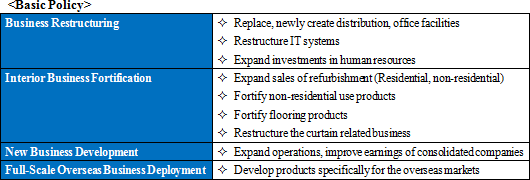 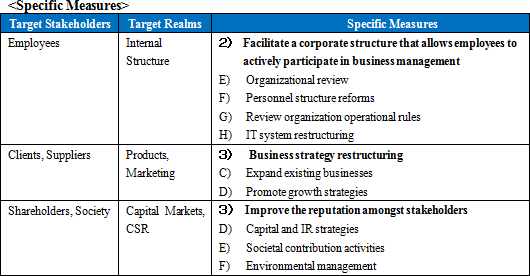 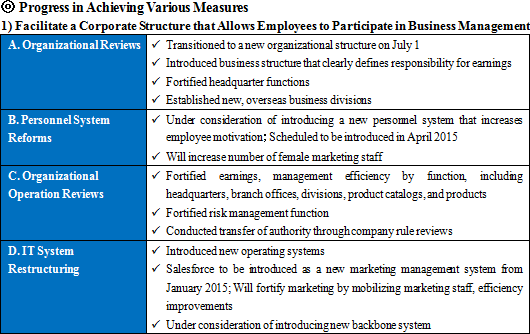  3) Improve Corporate Reputation with Stakeholders
Based upon the identification of ongoing improvements of corporate value as the basic means of returning profits to shareholders, Sangetsu has sought to implement a stable level of dividends. (The combined total dividend payout over the past five years amounts to over 70%) In addition, the Company has implemented a management strategy that places a priority upon safety of its balance sheet in addition to sales growth and profitability. However, Sangetsu recognizes the necessity of making a shift in its management strategy that favors efficiency of the balance sheet and considers cost of capital in addition to safety and expansion of earnings in light of the recent Japanese capital market conditions. Consequently, the Company announced a capital strategy as detailed below on November 7, 2014.
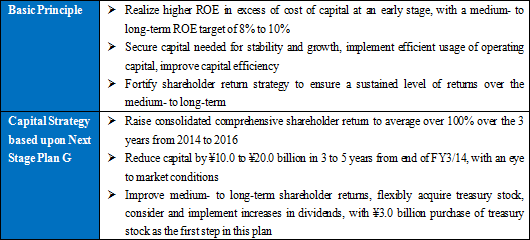   ◎Targets to Be Achieved Between 2017-2019 Based upon this midterm business plan, the next midterm business plan is expected to end in fiscal year March 2020 and maintains the themes of "realizing profitability of new, overseas businesses, and consolidated subsidiaries," "steadily expand earnings of the interior business," and "introduction of new capital strategy." In addition, the next plan maintains a "target of achieving ROE of 8% to 10%." Disclaimer
This report is intended solely for information purposes, and is not intended as a solicitation to invest in the shares of this company. The information and opinions contained within this report are based on data made publicly available by the Company, and comes from sources that we judge to be reliable. However we cannot guarantee the accuracy or completeness of the data. This report is not a guarantee of the accuracy, completeness or validity of said information and or opinions, nor do we bear any responsibility for the same. All rights pertaining to this report belong to Investment Bridge Co., Ltd., which may change the contents thereof at any time without prior notice. All investment decisions are the responsibility of the individual and should be made only after proper consideration.Copyright(C) 2015 Investment Bridge Co., Ltd. All Rights Reserved. |

